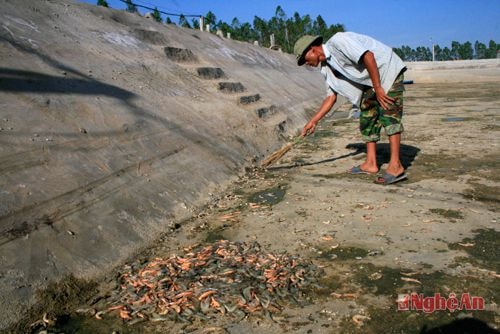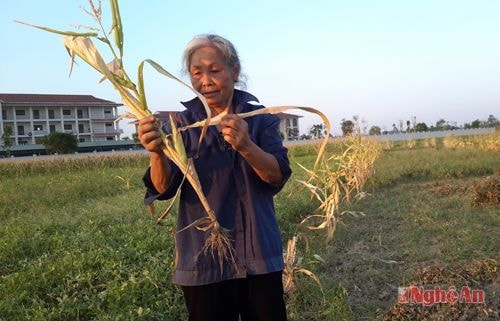Heat waves cause damage to agricultural production
(Baonghean) - The temperature of approximately 40 degrees Celsius in recent days in Nghe An has caused shrimp in shrimp farms in Quynh Luu district, Hoang Mai town, Hung Hoa commune (Vinh city) to die en masse; corn fields in many localities have also dried up...
Mass shrimp deaths
We arrived at Quynh Xuan ward (Hoang Mai town) at noon when the weather was around 40 degrees Celsius. The "heat" was even more intense in the hearts of shrimp farmers when many shrimp ponds were dying. At the shrimp pond of Mr. Nguyen Van Thinh, when he and his family members were scooping dead shrimp out of the pond, Mr. Thinh sadly said: "The area of the family's pond is 7 hectares with nearly 700,000 shrimp. The shrimp were released 1 month ago, almost as big as a finger... But in the past 3 days, the shrimp have been floating and dying en masse, unable to be saved. The initial cause, I guess, is that the high temperature causes the shrimp to have a digestive disease, also known as white feces disease. After being infected for 2 to 3 days, the shrimp will die and die even faster as the disease spreads. The whole family was unable to react in time!...".
Arriving at block 7 Quynh Xuan, entering the shrimp pond of Mr. Tran Van Hai when he was cleaning up the dead shrimp at the bottom of the pond, the pond water had been drained, the dead shrimp were burning hot on the surface of the pond. He said that currently, the whole block has nearly 70 shrimp farming households, of which 40 households have lost over 30% of their output. His family raised 400,000 shrimp in an area of 6,000m2, after a month and a half the shrimp were almost mature, suddenly the shrimp got sick and died. After only 2 days, the number of shrimp floating on the water surface, washed ashore when weighed reached 300kg. Therefore, his family was forced to harvest the remaining shrimp in the pond immediately to prevent the disease from spreading, and at the same time treat the pond. Through investigation, it is known that currently the total shrimp farming area of Quynh Xuan ward is 45 hectares, during the prolonged hot weather in recent days, nearly 15 hectares of shrimp raised in the first batch of this year died. The most damaged blocks are block 5, block 4, block 7. To overcome the above situation, many farmers said they have overcome it by mixing lemon juice or vitamin C into shrimp feed to increase resistance, however this method does not bring positive results when the weather is still extremely hot.
 |
| Mr. Van Duc Truong (Mai Hung ward, Hoang Mai town) is cleaning up dead shrimp to treat the pond after draining the water. Photo: TQ |
Hoang Mai town released shrimp in the main crop this year with a total area of 485 hectares. The new thing for shrimp farmers here is the change in shrimp release season. In previous years, farmers released 2 crops, crop 1 from March 15 to April 30, crop 2 from July to September, but this year, they only produce the main crop and release the seed from March 15 to June 30. Changing the crop structure like that has the advantage of improving production quality. However, the limitation is that around May and June, the weather is quite hot and the salinity of the water increases, making it difficult for the development of the seed; the high and prolonged temperature in recent days has caused shrimp to get sick en masse.
Mai Hung Ward is also a locality with a large shrimp farming area in Hoang Mai Town. Currently, people here are struggling to cope with the hot weather. Regarding this issue, Mr. Nguyen Duc Truong, Head of the Shrimp Farming Cooperative of the ward and also a shrimp farmer, shared: "Mai Hung Ward has a total shrimp farming area of 28 hectares of 60 households. In the past 4 days, shrimp have died in all ponds. Faced with this situation, some households have pumped water to supplement the ponds or harvested shrimp to treat the ponds."
Quynh Luu district has a total area of 400 hectares of white-leg shrimp farming. However, at this time, some shrimp farming areas in the district have been infected with white feces, hepatopancreas, white spots and the damage has not been calculated yet. Just calculating the cost of special medicine per hectare of shrimp and pond renovation work has reached tens of millions of VND. On the other hand, because the time of disease outbreak and spread of shrimp is quite fast, prevention and treatment are very complicated. Up to now, the infected area has been discovered in An Hoa commune; the whole commune has 84 farming households with a total area of 44 hectares, currently nearly 20% of the shrimp area is infected. Mr. Le Van Quyet, Vice Chairman of An Hoa Commune, said: “To promptly overcome the above situation, the commune and agricultural extension officers have proposed temporary solutions. The most important thing at this time is to ensure that the water level in the pond fluctuates between 1.3 and 1.5m. It is necessary to supply water to compensate for the amount of water that has evaporated and carefully treat it through a settling tank to ensure that the water supply is hygienic.”
To better understand the cause of the recent mass shrimp deaths in localities, we talked with Mr. Tran Xuan Hoc, Head of the Aquaculture Department, he said: "Currently, the whole province has released 1,220 hectares of shrimp, including 1,200 hectares of white-leg shrimp. According to statistics up to May 30 of the Aquaculture Department, the area of dead shrimp is nearly 28 hectares. The cause of shrimp deaths may be due to the hot weather causing algae in the pond to grow very quickly and densely, this type of algae is very popular with shrimp, among these are many types of toxic algae or dead and decomposing algae, when shrimp eat too much toxic algae combined with hot weather, it leads to digestive diseases. Another reason is that farmers often feed shrimp too much during the hot season, while we have recommended limiting shrimp feeding. The amount of excess food in the pond can also easily cause shrimp poisoning due to bacterial infection. In addition, the water supply for shrimp ponds in Hoang Mai town comes from the Mai Giang river, the water source here The river is also heavily infected, the river has signs of sedimentation, the water level is no longer as abundant as before, causing pathogens in the water source to remain. And another reason for the shrimp death could be due to hepatopancreatic disease, white spot disease...
Regarding the solution to the dead shrimp ponds, Mr. Tran Xuan Hoc said: The Department of Aquaculture regularly sends official dispatches to advise shrimp farmers on weather developments. When many shrimp die, shrimp farmers need to close the drain to treat the pond. They must immediately notify the commune veterinary officer and handle the situation properly. Shrimp farmers need to coordinate with the commune veterinary officer to accurately test the disease on the shrimp. If there is hepatopancreatic disease and white spot, the state will support chlorine to treat the pond, but other diseases will not be supported. After putting chemicals in the shrimp pond, it is necessary to leave it for 5-7 days, then collect the shrimp carcasses and destroy them. Destruction must be done in the right place to avoid the spread of residual pathogens. The area of infectious ponds after treatment must wait 1 month before continuing to raise them. Farmers also need to pay attention to the density of shrimp stocking, should not stock too densely, if the quantity is not controlled, it is easy to feed indiscriminately.
Burnt corn
 |
| Corn in Nghi An (Nghi Loc) has almost no kernels. Photo: PH |
The severe drought has caused many areas of late spring - early summer-autumn corn in the districts of Nghi Loc, Thanh Chuong, Anh Son, Con Cuong... to dry up. The area of corn that has dried up in the localities is about 400 hectares. Ms. Nguyen Thi Loan, hamlet 12, Nghi An (Vinh city) has an area of dead sticky corn. She peeled the corn to show us and it was true that the corn only had a few kernels due to the effects of extreme weather and did not receive enough nutrients when it was time to form grains. Ms. Nguyen Thi Hang's family, hamlet 20, Nghi Van (Nghi Loc) also had 2 sao of corn that died, she had to harvest it to feed livestock. It is known that Nghi An commune has been using the hybrid corn variety PAC 399 for a few years now. In previous crops, although the stalks were short, almost every plant had 2 ears, big ears and full kernels. However, this year, the whole area has lost them.
In Nghi Van (Nghi Loc), although hybrid corn was planted, due to severe drought, the entire corn field of 250 hectares was destroyed. Mr. Dang Ba Huong, Vice Chairman of Nghi Thach Commune People's Committee, added: Nghi Thach corn is planted on poor sandy soil, in good harvest years, the corn yield is only 2.5 - 2.7 quintals/sao. This year, 70 hectares were planted late due to hot weather, prolonged drought right at the stage of corn flowering and pollination, so the beans are very poor, about 15 days to harvest but the yield may only reach 50 - 60 kg/sao. Mr. Nguyen Van Sao, Chairman of the Commune People's Committee, worried: Nghi Van has 250 hectares of corn burned to death, almost no yield. Besides, 330 hectares of spring peanuts, although it is time to harvest, the soil is too dry and hard so people have not been able to harvest.
It is known that this spring crop, with the policy of prioritizing the development of corn areas, the whole province planted nearly 17 thousand hectares of corn, with corn varieties with high yield potential such as DK 6818, DK 9901, C919, LVN 14... Up to now, corn fields in Nam Dan and Hung Nguyen districts have been harvested. However, some corn fields planted later (late spring corn - early summer-autumn corn) in Thanh Chuong, Yen Thanh, Nghi Loc districts... are blooming, or corn fields on sandy soil in some localities in Vinh City, Nghi Loc are about to be harvested, but are heavily affected by drought. If the heat continues in the coming days, it is likely that more corn fields will be burned to death and not yield.
Thanh Quynh - Phu Huong
| As of June 2, drought in the province has widely affected agricultural production: In Anh Son, 138 hectares of tea are at risk of dying, 800 hectares of rice fields cannot produce; Tan Ky has lost about 500 hectares of spring-summer corn; Quynh Luu has about 3,000 hectares of rice fields without water for summer-autumn crop production; Lam River is also gradually drying up... Many localities are struggling to fight drought to be able to produce summer-autumn crops on time. |






